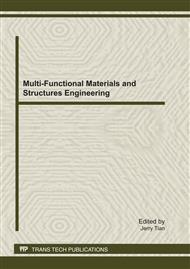[1]
YAO Zukang. Manual of Highway Design (Pavement), " 3nd edition. Beijing: People, s communication press, (2006).
Google Scholar
[2]
HUANG Y.H. Pavement Analysis and Design. Beijing: People's communication press, (1998).
Google Scholar
[3]
XIE Hongbing and YAO Zukang, Resilient modulus of the asphalt treated drainage base material, Journal of Highway and Transportation Research and Development, 2001, vol. 18(4), p.4–7.
Google Scholar
[4]
KOU Yanan and WENG Xingzhong, Service life prediction for cement airport pavement using artificial neural network theory, Chinese Journal of Highway Engineering, 1997, vol. 10(1), p.16–20.
Google Scholar
[5]
WANG Yanli and WANG Binggang, Prediction of pavement service performance using artificial neural network, " Journal of Xi, an Highway Transportation University, 2001, vol. 21(1), p.42–45.
Google Scholar
[6]
XIONG Hejin, Pavement distress diagnose based on neural network, Journal of Highway and Transportation Research and Development, 2001, vol. 18(1), p.10–12.
Google Scholar
[7]
LI Zhigang, LIU Xinjie, DENG Xuejun, Decision-making moethod of highway pavement based on neural network, Journal of Highway and Transportation Research and Development, 2001, vol. 18(4), p.28–30.
Google Scholar
[8]
LIU Jianyong, Prediction of settlement for highway soft soil foundation using artificial neural networks, Journal of Highway and Transportation Research and Development, 2000, vol. 17(6), p.15–18.
Google Scholar
[9]
MAO Cheng, QIU Yanjun, Prediction of resilient modulus of asphalt pavement material by artificial neural networks, Journal of Chongqing Jiaotong University, 2002, vol. 21(3), p.26–29.
Google Scholar
[10]
Feipeng Xiao, and Serji N. Amirkhanian, Artificial Neural Network Approach to Estimating Stiffness Behavior of Rubberized Asphalt Concrete Containing Reclaimed Asphalt Pavement, Journal of Transportation Engineering, 2009, vol. 135(8), p.580–589.
DOI: 10.1061/(asce)te.1943-5436.0000014
Google Scholar
[11]
Xiao, F. P., Amirkhanian, S. N., and Juang, H. C. Prediction of fatigue life of rubberized asphalt concrete mixtures containing reclaimed asphalt pavement using artificial neural networks., J. Mater. Civ. Eng., 2009, vol. 21(6), 253–261.
DOI: 10.1061/(asce)0899-1561(2009)21:6(253)
Google Scholar
[12]
http: /www. heatonresearch. com/articles/5/page2. html.
Google Scholar


